2015-02-18 By Ed Timperlake
“You know that stealth may be over-rated,” Admiral Greenert, the Chief of Naval Operations, recently noted during a speech at the Office of Naval Research Naval Future Force Science and Technology Expo, Washington D.C.
“I don’t want to necessarily say that it’s over but let’s face it, if something moves fast through the air and disrupts molecules in the air and puts out heat – I don’t care how cool the engine can be – it’s going to be detectable.”
The CNO is exactly right.
Admiral Jonathan Greenert, a nuclear trained Navy submarine officer, and General Mike Hostage the recently retired Commander of the USAF Air Combat Command and an F-22 pilot are in agreement on the dynamic nature of “stealth.”
From General Hostage’s last interview before retirement and one which he did with us:
People focus on stealth as the determining factor or delineator of the fifth generation. It isn’t; it’s fusion.
Fusion is what makes that platform so fundamentally different than anything else.
And that’s why if anybody tries to tell you hey, I got a 4.5 airplane, a 4.8 airplane, don’t believe them.
All that they’re talking about is RCS (Radar Cross Section).
Fusion is the fundamental delineator. And you’re not going to put fusion into a fourth gen airplane because their avionic suites are not set up to be a fused platform.
And fusion changes how you use the platform.
Just like in Admiral Greenert’s initial warfighting community, the U.S. Navy’s submarines “silent service,” airpower commanders have the same type of relative technology dynamic against a reactive enemy but in a different medium.
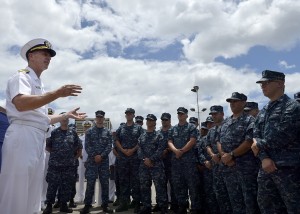
Both communities have to be ready to fight in a very dangerous three-dimensional maneuvering environment where active and passive sensing and weapons and countermeasures to those weapons mean the difference between life and death.
In our discussions with Dr. Mark Lewis, former Chief Scientist of the USAF and currently head of the Institute for Defense Analysis Science and Technology Policy Institute, we focused on one of the bigger threats coming sooner rather than later to be facing all warfighters in many nations, the hypersonic cruise missile.
Dr. Lewis is a leading expert on hypersonics.
We interviewed Dr. Lewis in the context of rolling out an F-35 fleet with the rapidly approaching Hyper-Sonic Cruise Missile (HSCM) as a new weapon of war.
HSCMs are part of what one might call an S Cubed formula for thinking about military critical technologies for 21st-century targeted R&D.
S-cubed=sensors-stealth-speed of weapons can provide a new paradigm for shaping a combat force necessary for the US Military to fight and win in 21st century engagements.
Stealth or no stealth the F-35 fits perfectly into the S3 revolution in modern war
No matter which path is taken, the F-35 as a single platform with all three attributes combined or as a non-stealth sensor platform, employing speed of weapons carried organically or trading off with other platforms at the speed of light by giving incoming target vectors to their weapons.
A point implicit in the CNO’s discussions is that the order of the words is very important.
Starting with sensors, then stealth and speed (again of weapons) they can be combined in one stealth platform or as appropriate stealth and speed can be traded off against one another using a separate platform.
CNO Admiral Greenert has pointed this out before.
As Admiral Greenert correctly points out, improved radars and sensors continue to chip away at stealth. Military advances in technology are always relative against a reactive enemy and are not absolute. Stealth is simply an airframe survivability design feature. Stealth is everything until it is nothing.
How fast an erosion of stealth design features is a critical question as well as the meaning of detecting stealth within a fluid and rapidly evolving battlespace.
Airframe design characteristics are all blended together in tradeoffs and have been focused on constantly improving, payload (improved by systems/and weapons carried), maneuverability (measured by P Sub s), speed, and range (modified by VSTOL–a basing mobility plus factor).
Stealth was a clean sheet design for F-22 and F-35 and is embedded in the total airframe and it is a very sensitive multiplicative factor; one does not add stealth. Additionally like all modern fighters stealth aircraft are also designed with inherent other survivability factors, such as system redundancy and hardening.
The CNO’s observation is very true.
Stealth is simply a survivability term that impacts the entire airframe and will eventually decline as better sensors are developed.
This is also why passive sensing is also a real revolution. Passive sensing can attenuate the problem of generating active “signals in space” which often can give away a platform’s position either maneuvering or an absolute fixed location for a counter- attack.
Stealth dynamically over time will become more vulnerable as enemies sensors improve.
How long and against what enemy, and where in world will the ant-stealth sensors and successful weapons be employed is unknown, but it will occur.
The CNO being a Nuke engineer is also exactly right about heat signature. But the US and our allies are also a reactive enemy and a SAM or Cruise missile launch also puts out heat. And so far any enemy still needs a period of active sensing for target acquisition. That requirement is often expressed as “emit you die.”
Modern air combat, just like submarine warfare is essentially an evolving contest of “blind man’s bluff.”
Even if and when stealth survivability deteriorates–ENTER the F-35 fusion cockpit with passive sensing and a significant payload of hard points.
External weapon hard-points on the F-35 are a brilliant design aspect, which is often overlooked in most discussions.
The non-stealth F-35 can sling more ordinance than F/A-18 and F-16.
So even in a non-stealth world, advantage goes to F-35, with its 360 active and passive horizontally linked cockpit decision-making ability.
As the CNO says “payloads over performance.”
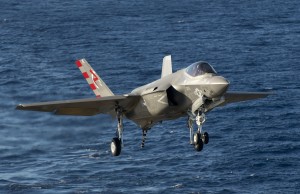
Employing stand-off weapons with current and better payloads the F-35 still wins any combat comparison because the S-3 formula kicks in as a combat reality.
An F-35 as a non-stealth fleet still has a 360-degree sensor platform with “reach not range” as a fundamental fleet enabler.
It is an information dominance fusion platform that can be favorably compared to the equivalent of being a 21st Century version of USN Destroyers standing very dangerous and heroic radar picket duty protecting the Amphibious invasion force and Carrier Fleet against kamikazes off Okinawa.
As the CNO pointed out “something moves fast through the air and disrupts molecules in the air and puts out heat – I don’t care how cool the engine can be – it’s going to be detectable.”
Only this time against the HSCM and also a lesser-included problem of killing slower cruise missiles if F-35 did not exist it would have to be invented.
In other words, an additional benefit of R&D and con-ops efforts to kill HSCMs makes taking down conventional CMs much easier.
It is now time to accept that a war-changing weapon, HSCM is in the late stages of R&D and it must be accounted for in any battle plan. Unlike distant “hyper-sonic” R&D efforts such a Global Strategic Strike aircraft, a hypersonic cruise missile is a rapidly evolving technology, which sooner than later will be demonstrating the art of the possible up close and personal. Such a revolutionary CM in the US arsenal is a very good thing. In the hands of PLA forces it is a very real “wolf at the door.”
Consequently when, not if, a hypersonic-Cruise Missile is battle ready the Air/Sea Battle staff will have to figure out both offensive and defensive con-ops. In sufficient numbers a hypersonic Cruise Missile can be a war-tipping asset. Employed by US and Allied forces the capability will greatly enable a deadly combat punch.
If it is in the hands of an enemy a hypersonic Cruise Missile is a ship killer.
The Cold War USN CBG protection mantra against Russian Bombers with anti-ship cruise missiles was to try and first kill the archer not the arrows.
Top Gun in the late eighties briefed “Chainsaw” tactics, and the F-14 was very well designed for long-range interception of threats against the Fleet.
“Chainsaw” was a focus on reaching out as far a possible against any threats.
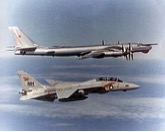
Now if Russian and/or PLAAF successfully air launch HSCMs or their missiles are launched from ground batteries or surface ships or subs (USN fast attack subs are of utmost importance in that battle) they will be engaging in their version of the S-3 formula. Just like the USN and USAF they first need sensors to make it all work. The order of the “S” words in the priority of formula is very important.
If they develop a HSCM to empower their fighting force the F-35 does not have to fight in the stealth mode against HSCMs. Even if HSCMs move at Mach 10 an F-35 sensor platform moves “trons” at the speed of light and this can make all the difference.
It is very evident that all fighting forces need both reach and range. The F-35 today can play both stealth and non-stealth and is a generation better than any other aircraft in the world. One just has to look at Russian and PLAAF attempts to develop a real F-35 capability and their stealth airframe is lacking the sensor systems comparable to F-35. It is a pure marketing assertion that they have fusion parity and DAS.
The F-35 “360 Degree Fusion Cockpit” is good for a decade or more as the never ending action/reaction cycle of our enemies attempt to make their technology and training moves to catch up to US.
US and its Allies are the only airpower thinkers and practitioners that can learn TTPs when F-35, F-22 and legacy aircraft mix it all up at a Red Flag. Russian and PLAAF cannot do that training within a decade. They might claim that they are building fusion cockpits in stealth jets-but currently just by looking at their airframes with no nose sensors or wing sensors, they are simply fusing linear improvements to radar systems. They do not have the complete 360-active/passive reach that the F-35 brings to AA, AG and EW fight.
There is one other significant factor of HSCMs.
A ship has an advantage in that it can maneuver at sea, it also has a distinct disadvantage if a mortal blow is landed it sinks.
Whereas an airfield has a disadvantage in that it is a very well-known fixed point on land but an airfield has a significant advantage in that it can be fortified and also have an operational chance with rapid runway repair and other battle damage repair.
Both the US Navy and US Air Force have the vision and resources to develop the most modern training ranges in the world and a dedicated unified approach to collecting operational intelligence against HSCM airborne “signatures.”
During a visit to Nellis AFB Major General Jay Silveria, Commander of the USAF Warfare Center, pointed out that one of the missions of his command is to create a mission file for the F-35 fleet.
“The mission file includes all of the data about every threat, aircraft, surface-to-air missile, blue aircraft, and airliner, whatever that airplane may see during its flights.
That intel mission data will fill the mission data file that will build is what the airplane then goes in and looks to see when it fuses that target.
The mission data file that we’re building right now in the 513th at the 53rd wing which are part of the Warfare Center were initially building are for the Marines.”
The value is that USAF, USMC, USN and Allis have the possibility of working off that same mission data library.
The very practical application and perhaps battle tipping aspect of a fleet wide mission data file is that if just one F-35 anywhere anytime gets hit on a HSCM, the entire fleet can have the data.
This is unique capability to be able to prevail in modern war.
Concurrently, the Navy at Fallon is also building a significant training complex for practicing current con-ops and looking forward to studying how to defeat future threats.
Rear Admiral Scott Conn is Commander of Naval Strike and Air Warfare Center.
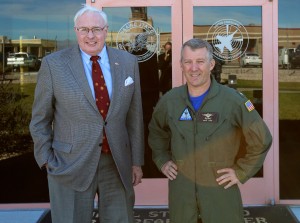
He and his team are spearheading a broad based effort to expand the envelope of training to combine live and virtual training by building a Live, Virtual, Constructive (LVC) training range
Rear Admiral Michael Manazir, Director of Naval Air Warfare identifies the Navy way ahead that will allow tactical innovation and practices for the best way to attack and destroy incoming HSCMs:
The threat baseline that we’re looking to fight in the mid-2020s and beyond is so much more advanced that we cannot replicate it using live assets. And those advances are in the aircraft capability, the weapon capability, and in the electronic warfare capability of the threat systems. That drives us to thinking about a different way to train.
Live, virtual, constructive (LVC) training is a way to put together a representation of the threat baseline where you can train to the very high end using your fifth generation capability. Some of it is live with a kid in the cockpit, some of it is virtual in a simulator, and so “virtual” is actually the simulator environment. And then constructive is a way to use computers to generate a scenario displayed on either or both of the live or simulated cockpit.
You can also combine them to be live-constructive, or virtual-constructive, and by that I mean there are systems out there right now that you can install in the airplane that will give you a constructive radar picture air-to-air and surface-to-air along with the electronics effects right onto your scope.
You’re literally flying your airplane, and through a data link, you can share that information between airplanes, you can share it between dissimilar airplanes.
Thus a key way ahead for R&D and con-ops to deal with the coming HSCM threat is clear.
The F-35 does not have to be in a stealth mode to sense and engage against HSCM racing at a CBG–it can go out and loiter as a 360-sensor picket platform.
My initial paper “winning Air/Sea Battle” only looked at F-35 as early warning only platform.
Essentially, the F-35s are seen giving a “heads up” to Fleet surface ships about “incoming” missiles threats but in the non-stealth mode the F-35 can carry more ordinance than F/A-18 or F-16.
So instead of just a “heads-up” to the Admiral commanding the CBG to make ready his fleet for close in defensive measures, why can’t an F-35 carry anti-HSCM designed ordinance to kill HSCMs in flight. Design a missile that can link to the fusion cockpit for an immediate fire control solution and immediately launch a missile with an appropriate warhead to take down an incoming HSCM.
In an email exchange with Dr. Lewis, he has raised a significant challenge which needs to be addressed in R and D and the shaping of effective con-ops.
“ The biggest threat I see is actually a swarm attack of high-speed incoming, that might overwhelm any solution. The Chinese have been rather open about this tactic.” It is very fair to say it is truly a wicked problem, but he also adds; “the good news is there are indeed solutions that will stop them.”
The one point in favor of the HSCM intercept to a kill shot is the need to just get in front of the missile with something that abruptly and directly disrupts its forward motion. The key to defeating it is to make it beat itself to death– the old joke about you only have to be close in Horseshoes and hand grenades applies.
Again quoting Dr. Mark Lewis from that email exchange:
One method of stopping them simple kinetic will be effective, with the challenge that a high-speed maneuvering missile will be rather hard to catch with dumb ordnance. And with a rapid closing speed, the window for that kill chain is of course small.
There are other very promising options as well.
Stability and control of a hypersonic craft is a key element. The DARPA HTV-2 failed twice due to control losses, something that the Air Force warned DARPA about ahead of time. In the case of HTV-2 flight 1, the loss occurred due to yaw-roll coupling; essentially, the vehicle developed a small asymmetry, began to yaw, and corrective control action caused it to roll out of limit. That was a case of bad design, but also an example of how easy it is to mess with these craft. HTV-2’s second flight was lost because an important protection system failed again making it uncontrollable.
I can’t help drawing an analogy to the old German V-1’s, that could be disabled by flying alongside in a fighter and hitting their wing tips. The resulting roll made them unstable!
The third flight of X-51, where a fin broke off the cruise vehicle during solid rocket boost, and when it separated from the solid motor (at Mach 4.8) it almost immediately lost control. So when you are flying at hypersonic (or even supersonic speeds) and take even minor damage, survival is unlikely. Coincidentally, and as a funny historical quirk, there is a pretty long list of hypersonic programs that have been lost due to fin failures completely unrelated to the hypersonic portion of the flight: X-43 first flight, the Australian HyShot first flight, and now most recently, AHW’s second flight.
That last one is especially painful; the booster lost a fin a few inches above the launch pad due to an entangled thermal blanket.
A hypersonic missile must travel between Mach 5 and Mach 10, or 3,840–7,680 miles per hour in order to be considered hypersonic.
By comparison, a current missile AA missile, the AIM-120 (accurate wiki graphic) has the following characteristics:
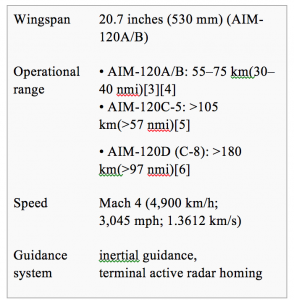
Credit Graphic: Wiki
Thus, there is a speed differential of between 1 and 6 Mach and also the HSCMs are also in flight, the intercept missiles are at a standing start.
The first look at intercepting a HSCM inbound against the fleet is one of the first verbal math problem we all had in Algebra 1-“A train leaves a station going 50 mph… Another train leaves it’s station going 80 mph.. etc etc.”
The logic of that example is that both HSCM and intercept missile are on the “same track” and a parallel track for a perfect “face-shot.”
However, the crossing angle to intercept may be much more significant, say for example an F-35 flying on a heading of 090 and the pilot’s cockpit’s fusion display picks up a HSCM coming at the Fleet heading 180 and the closes point of approach for the physical passing of the F-35 on station and HSCM for intercept is offset by say 30 miles and at a different altitude.
The F-35 sensor shooter for an example could be 90 degrees off the nose for an intercept vector and also off set by some miles and altitude from the physical closes point of approach, this is a very hard shot. The F-35 at best can try to point and shoot with the missile arming and independently maneuvering but having been initially launched many degrees off the aircraft’s initial route of flight.
The challenge is that at some point in space and time the kill missile must get in front of the HSCM. It is not necessary to hit a bullet with a bullet. With the current significant Mach differential shown above a conventional missile cannot run down a HSCM. With focused R&D perhaps a future hypersonic -interceptor missile is possible-but in this example I am using the current art of the possible and assuming a +6 Mach advantage given to the HSCM and it is already in flight while interceptor missile is on the rail at the start.
Therefore, detection and reaction time for launch and missile light-off the intercept angle for the missile altitude differential make time and distance of flight against HSCM everything. At around 88 miles per minute incoming, depending on altitude it is a very hard problem.
The first issue is simply just getting a missile off an F-35 in the time of calculation for sensing something approaching at a high rate of speed.
Using the CNO’s formula heat=sensing, an F-35 can see something moving very fast at a distance. How far away is one key BUT not a showstopper. Because if the F-35 can sense at a whatever distance it is reacting electronically at the speed of light and there is the possibility of doing something about it.
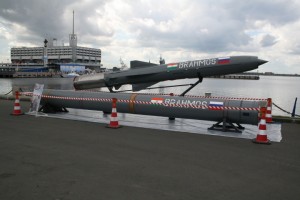
According to Russian state-media outlets, Army General Dmitry Bulgakov, the deputy minister of defense, told reporters on Tuesday that the ministry has developed special new fuel to enable missiles to fly at hypersonic speeds. Credit: The Diplomat
What can be done?
Slaving an immediate launch fire-control solution from the F-35 fusion cockpit sensed HSCM route of flight vector to an interceptor missile loaded on the aircraft hardpoints is one way.
But just as significant the F-35 sensor can off load the kill shot to another F-35 with a better chance.
To have any chance of success the launching F-35 has to have a certain head on aspect – if the HSCM is beyond the wing-line the engagement is lost at first detection. The kill-shot game for that one F-35 in launching a counter-missile is already be over.
But now think of a 21st Century “Chainsaw” as a solution set and a way ahead.
The USN strike commander is currently using F/A-18s to refuel F/A-18s. Since stealth in not an issue against an HSCM swarming missile attack, a mix of F-35s with F/A-18 tanking assets can put as many F-35s on a combat air patrol station as far away from the surface fleet as possible for early detection. That effort can then feed-back for defense in depth combat engagements.
Against even a Mach 10 threat the F-35 data linked information dominance sensor can off load at the speed of light the incoming track of swarming inbound HSCM threats to other F-35s standing CAP right over the Fleet.
Additionally, all USN combat platforms can also light up; AEGIS ships, Growlers, E-2 Hawkeyes and other close in defensive combat weapon systems:
https://www.youtube.com/watch?v=ttoWF3Oz2_w
Additionally, the Ford CVN-78 has been specifically designed with an area on the flight deck to configure the air wing aircraft quickly and efficiently with the appropriate ordinance for the appropriate mission. In alternating between offensive strikes, using active or passive stealth with weapons in a weapons bay or non-stealth with a significant weapons load, the combat ordinance on an F-35 can be configured quickly.
As the combat situation dictates the defensive requirements of loading anti-HSCM missiles as stated above can also be done quickly. USN ship design teams working on the CVN-78 figured this all out; switching ordinance and/or reloading. It is no small issue; the Japanese Carriers were sunk at the battle of Midway because they were caught in an arming, de-arming, arming cycle. From that moment forward they were going to lose the war.
The second critical point is that even if the F-35C is not arriving at the Fleet in time to counter a HSCM threat, Marine F-35Bs can be ready next year to pioneer modern “chainsaw” con-ops.
And as can be seen in this news report from India there is many ways to marry platforms with cruise missiles. If a supersonic cruise missile can be added to an Indian Navy platform the HSCM is but a simple step away from world-wide proliferation.
The challenge for the R&D community is to immediately give a lot of thought and research on what type of ordinance, missiles and warheads are best to defeat a HSCM.
Everything in this important field of research is an ongoing work in progress and U.S. and Allied Militaries and their industrial partners must be up to meeting this challenge.
This article only focuses on defense against HSCM.
Marrying an HSCM strike weapon to an F-35 enabled fleet opens up many other possibilities.
F-35 wide area targeting mapping capability against surface ships and shore instillations is beyond excellent.
So marrying up a HSCM into an F-35 strike package is a very strong battle winning technology match.
As a very smart Navy Captain said recently in discussing con-ops-“we have no problem using the word attack we are Naval Officers.”
Editor’s Note: Also see Ed Timperlake’s Special Report on Tron Warfare and the way ahead for airpower:
https://sldinfo.com/shaping-a-21st-century-approach-to-tron-warfare-2/

